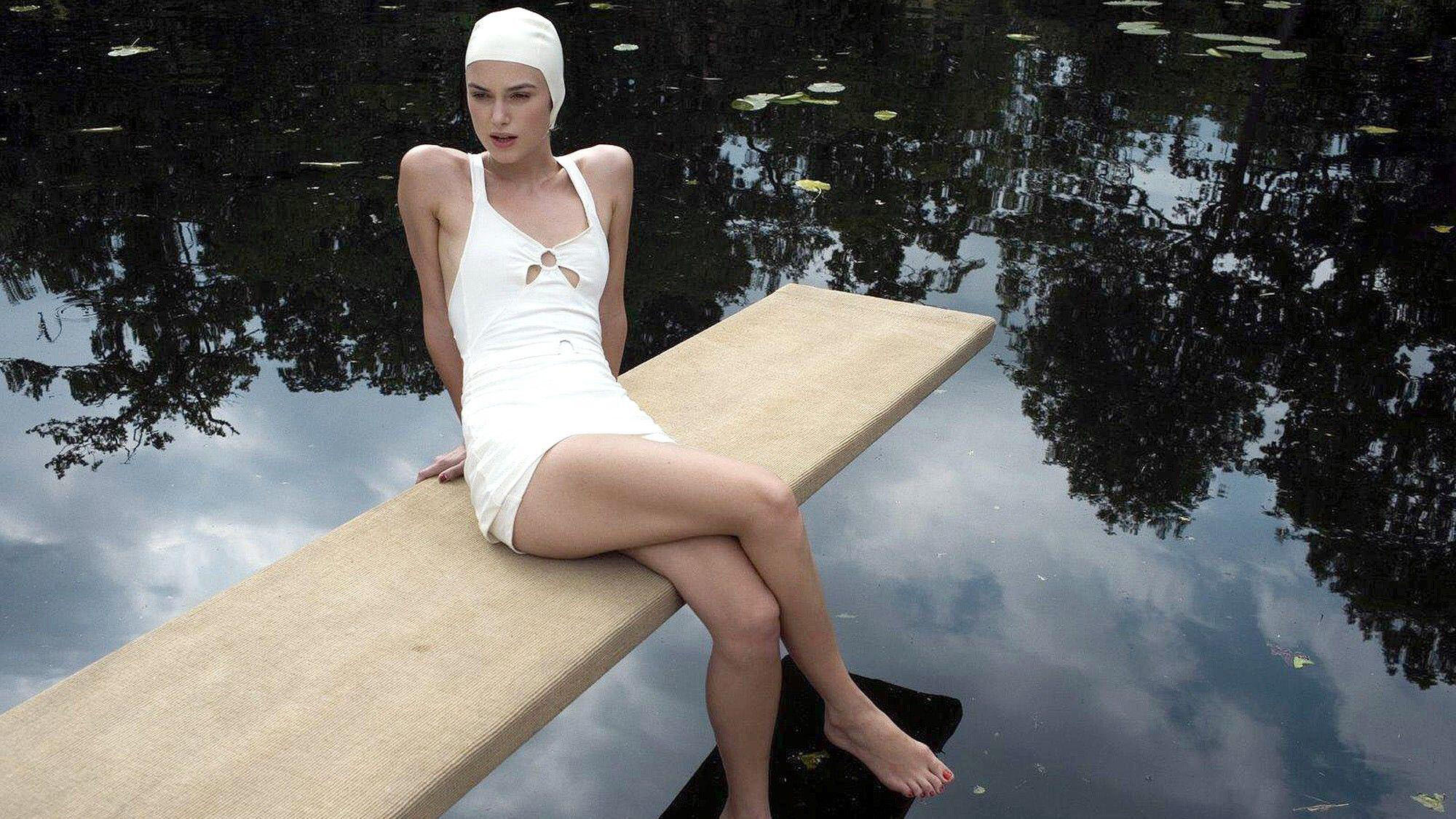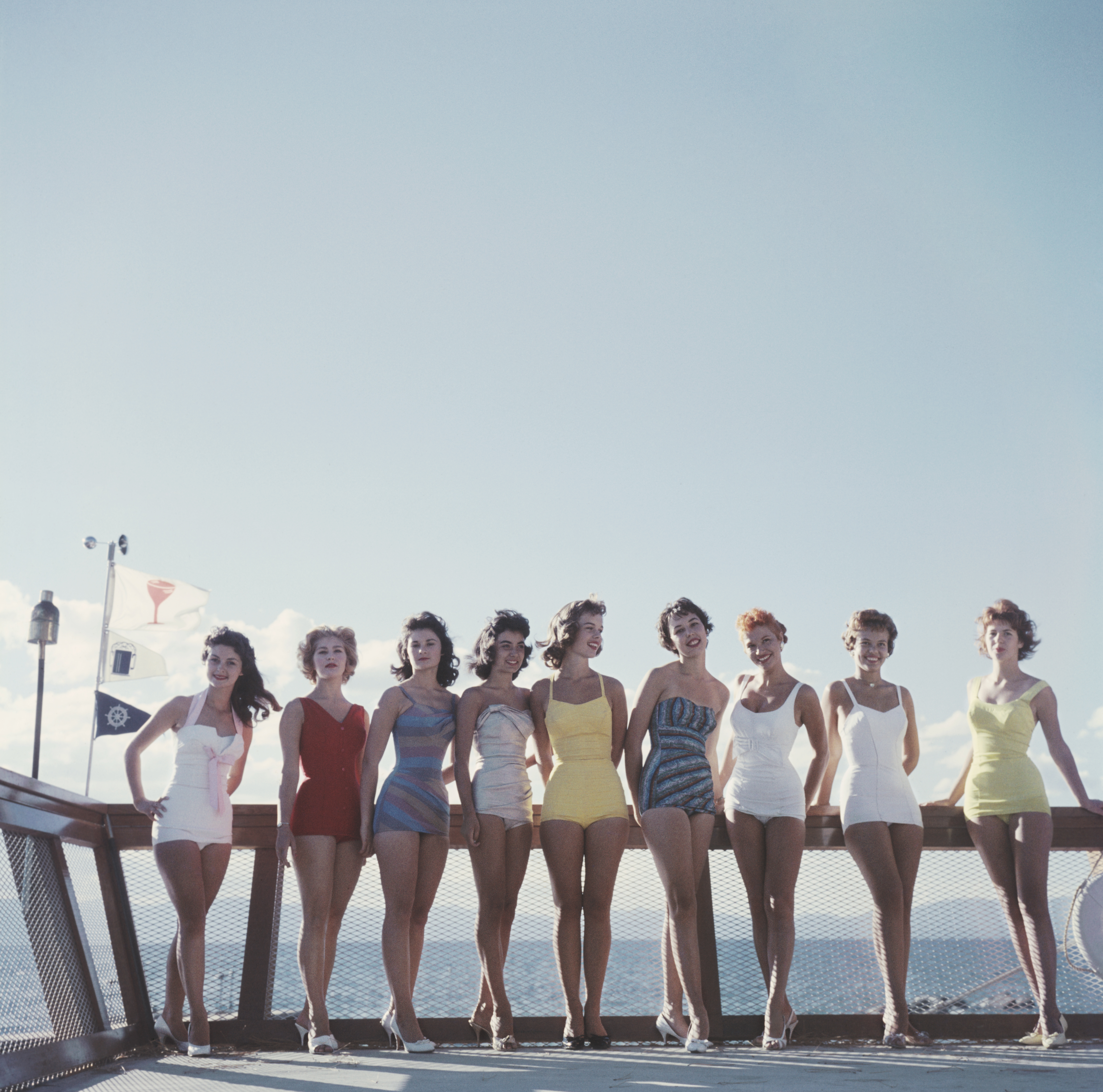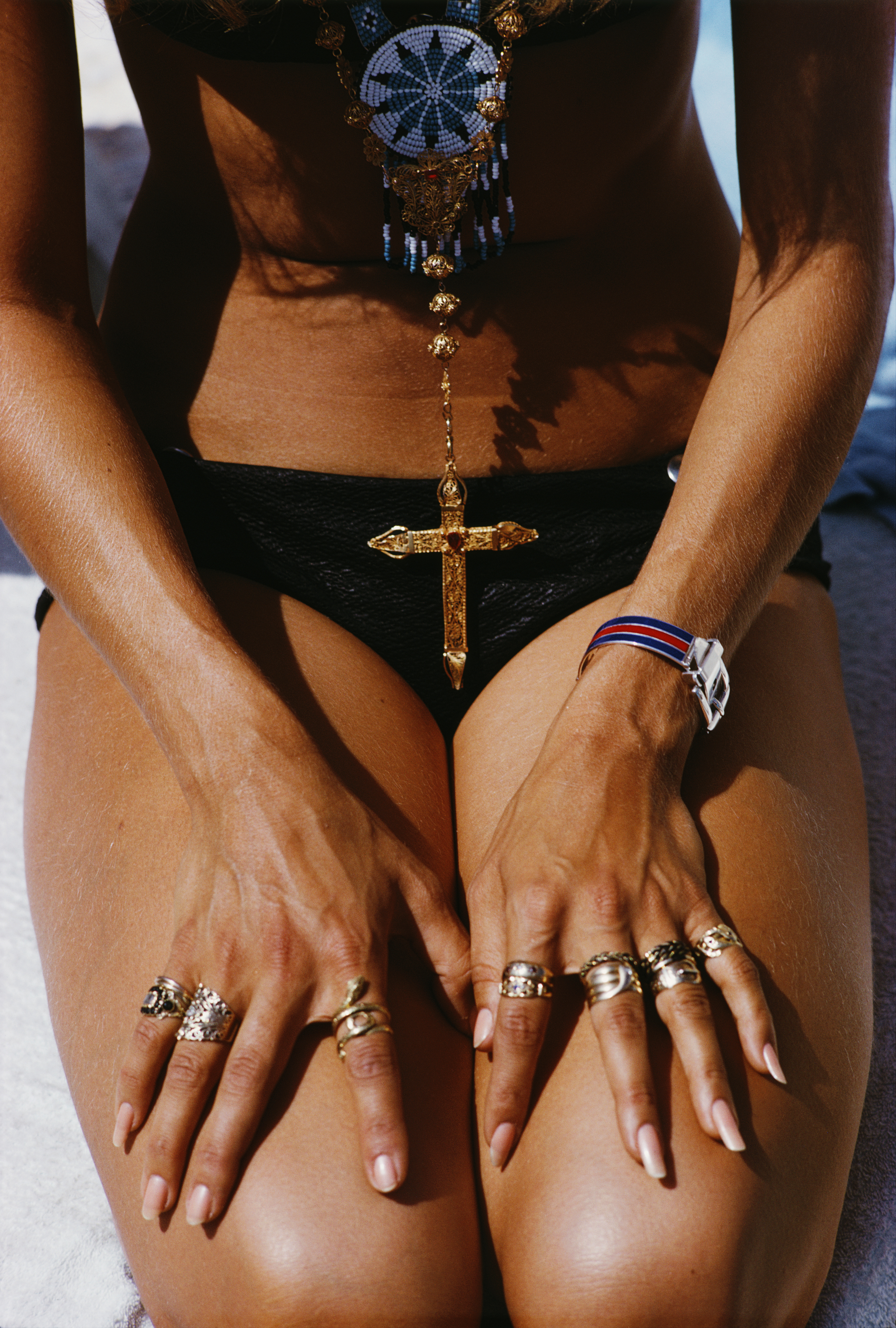No strings attached: A brief history of swimwear, from heavy skirts of linen linked to women's drownings, to the skimpy two-piece named after a nuclear weapons site
From knee-length numbers to a scandalous suit denounced by the Pope, the colourful history of swimwear has been brought to life by a glamorous London exhibition.


When the weather warms, cool water beckons. However, as we cast off our layers and slip into our swimsuits, we might perhaps spare a thought for our ancestors: it wasn’t so long ago that going for a dip entailed donning soon-to-be-sodden woollens, stockings (for women) and even shoes.
Few garments’ evolution reveals more about our social history and our changing relationship with our bodies than the swimsuit. ‘It really gives us an insight into themes such as modesty, display and which bodies are allowed into public spaces,’ notes fashion historian Amber Butchart, curator of ‘Splash! A Century of Swimming and Style’, a major exhibition currently running at London’s Design Museum. Divided into three sections — the pool, the lido and Nature — it charts the shifts in our love of swimming over the past 100 years alongside the clothing we have worn in the water, whether we’re splashing in the shallows or competing at the highest level. Highlights include a Union Flag-inspired swimsuit belonging to Paralympic champion Ellie Robinson and Olympic gold medallist Tom Daley’s Adidas trunks.

A group of young women in their bathing suits on the Nevada side of Lake Tahoe, 1959.
Wading a little further back to 18th- and 19th-century Britain reveals a nation populated by a majority of non-swimmers, who took to the water primarily to wash, cool off or revive themselves. ‘The salutary effects of sea-bathing… cannot be too strongly recommended,’ wrote Dorchester physician John Crane in 1795, extolling ‘the benign influence of the sea air’ and the water’s ‘purer’ vapour. Yet, the lack of suitable clothing made such exploits treacherous for women, particularly those who weighed down their hems with lead shot to prevent floating fabric compromising their respectability.
Men, on the other hand, would sometimes bathe nude or in their ‘drawers’, so it was unsurprising that bathing areas were strictly segregated and transgressions were taken seriously. According to an issue of the Yorkshire Post dated August 20, 1896, a gentleman caught teaching his sisters to swim was told by an inspector he had ‘no business to bathe with ladies’ and was issued with a court summons. Hindered by their clothing and discouraged from swimming, many women depended on the service of ‘dippers’, who would ease them into the sea from specially designed bathing machines: amphibious, horse-drawn changing rooms mounted on iron wheels.

A couple sunbathing by the sea at Palm Beach, Florida, circa 1955. Around this time strapless suits, made from shirred fabric with feature necklines, were common.
It took a teenager in the 1870s to turn the tide on modesty laws that were increasingly being linked to women’s drownings. Performing feats of endurance in a whale tank in Westminster’s Royal Aquarium and completing a 20-mile swim in the Thames, Agnes Beckwith showed what was possible when heavy skirts of linen and serge were swapped for a fitted one-piece. Yet women would have to wait another 40 years until higher hemlines went mainstream. A key turning point was the introduction of women’s swimming at the Stockholm Olympics of 1912, which necessitated a streamlined silhouette and saw female competitors sporting a similar one-piece to their male counterparts. In the meantime, the ‘Princess Suit’ — a bulky, knee-length sailor-style ensemble with matching bloomers — bridged the transition, often paired with stockings pulled up to the knee and laced footwear fashioned from canvas and cork.
Among the first form-fitting swimsuits to reach our shores were the rib-stitched woollen all-in-ones sold by Jantzen, an American knitting company, the racer-back designs of which — twinned with cosy bobble hats and socks — allowed for a better range of motion. With the motto ‘the suit that changed bathing to swimming’, the colourful garments meant that women could finally take the plunge. In the 1930s, Lastex, a thread derived from rubber, was woven into the suits, enabling the fabric to stretch over different body shapes and minimising the dreaded ‘sag’ when wet.
With women now on a more equal footing in the water, the concept of the family beach holiday took hold, booming more broadly with the advent of Billy Butlin’s holiday camps in 1936. Meanwhile, taking their name from Venice’s upscale beach destination in Italy, lidos sprang up, from Penzance to the Peak District, prompted by a rising national interest in fitness and open-air pursuits.
Exquisite houses, the beauty of Nature, and how to get the most from your life, straight to your inbox.
'The beach in particular, with its slackening social codes, became a crucible for new trends'
The beach in particular, with its slackening social codes, became a crucible for new trends; something it remains today. ‘You can wear clothing that is a bit more extravagant than you would wear in other public places: you can break a few rules,’ Butchart explains. ‘Beach pyjamas’, wide-cut trousers worn by women in the 1920s and 1930s with a matching top or jacket, were a case in point, appearing ‘at a time where wearing trousers in public in any other context was unacceptable for women’.
Beach pyjamas may have been unorthodox, but something far more shocking — and far smaller — exploded onto the fashion scene when French designer Louis Réard launched a skimpy women’s two-piece in 1946, naming it (rather tastelessly) after Bikini Atoll, where the Americans were testing nuclear weapons. One of the earliest surviving examples, in an eye-catching newsprint design, features in the exhibition and dates back to 1951, the same year that the Pope’s denunciation of the bikini saw it banned from Miss World. Undeterred, designers continued to amp up swimwear’s sex appeal: pieces with cinched-in waists and built-in brassieres, sold to the British public in affordable forms by brands such as St Michael and Deréta, enabled women to emulate the hourglass figures of silver-screen stars, such as Elizabeth Taylor and Diana Dors.
Also on show at the Design Museum is a display of Speedos, which proves that it isn’t only women’s swimwear that has shrunk over the years. The brand, now synonymous with tiny trunks, was founded in 1914 by the Scot Alexander MacRae, but it gained its famously diminutive form in the 1960s thanks to designer Peter Travis, who saw a market for improving its freedom of movement at the same time as showcasing the male physique. These new styles, for both men and women, were made possible by new materials. In the 1940s, British Nylon Spinners had created a hardwearing woven thread from petrochemicals that was lighter and less absorbent than wool, then Lycra, patented by DuPont in 1958, finally offered a product that felt like a second skin.

'The beach was becoming a catwalk': A kneeling sunbather shows off her rings and pendant on a beach in Capri, Italy.
The beach was becoming a catwalk. A ‘ritual of dressing up when you’re by the water’ was born, notes Butchart, together with ‘the idea of seeing and being seen’. Fashionistas paraded the latest in leisure-wear, from cat’s-eye sunglasses to espadrilles, as rubber swim caps embellished with petals protected immaculately coiffed hair. Swimwear colours, particularly later on, in the 1980s, became more flamboyant, with neons noisily announcing the bather’s presence, and designers experimented with graphic lettering, crinkly textures and bold cutaways.
Innovation today has taken a U-turn, moving away from oil derivatives and back to natural fibres, as well as exploring recycled materials such as Econyl, made from fishing nets and other nylon waste. We now see swimwear that offers UV protection, accommodates post-surgery bodies or is easier for those with mobility requirements to remove — all broadening access to this pleasurable pastime, however humble our technique. Roger Deakin, whose enduringly popular 1999 book Waterlog (featured in the exhibition) documented his mission to breaststroke through as much of the British Isles as possible, beginning with the moat around his Suffolk home, would surely have approved of the democratic spirit of the enterprise. ‘I am just an ordinary man-in-the-pool swimmer…’ he wrote. ‘My moat felt every bit as good as a Channel swim to me, and that was all that counted.’
‘Splash! A Century of Swimming and Style’ runs until August 17 at the Design Museum
Deborah Nicholls-Lee is a freelance feature writer who swapped a career in secondary education for journalism during a 14-year stint in Amsterdam. There, she wrote travel stories for The Times, The Guardian and The Independent; created commercial copy; and produced features on culture and society for a national news site. Now back in the British countryside, she is a regular contributor for BBC Culture, Sussex Life Magazine, and, of course, Country Life, in whose pages she shares her enthusiasm for Nature, history and art.
-
 ‘Calf’s brains have a bland, gentle richness that soothes and cossets': Tom Parker Bowles on the joys of eating offal
‘Calf’s brains have a bland, gentle richness that soothes and cossets': Tom Parker Bowles on the joys of eating offalEating offal it is more sinned against than sinning, but it offers the ultimate in magnificent, fully immersive eating.
-
 The wave of downsizing about to hit the property market in the UK
The wave of downsizing about to hit the property market in the UKThe Chancellor of the Exchequer's Budget — and specifically the 'Mansion Tax' — has fired a starting pistol for downsizers, and the waves will wash across the entire property market. Annabel Dixon spoke to property experts across the country to gauge how it will play out.
-
 Meet the British perfumers squeezing landscapes into scents
Meet the British perfumers squeezing landscapes into scentsThe nuances of modern perfumery now allow a single drop to evoke an entire landscape. Amie Elizabeth White explores the native houses hitting the right notes
-
 Sweet civilisation: What do you get when you ask architects to compete in a gingerbread competition?
Sweet civilisation: What do you get when you ask architects to compete in a gingerbread competition?The Gingerbread City is back in London’s Kings Cross. Lotte Brundle pays it a visit.
-
 Sophia Money-Coutts: A snob's guide to meeting your in-laws for the first time
Sophia Money-Coutts: A snob's guide to meeting your in-laws for the first timeThere's little more daunting than meeting your (future) in-laws for the first time. Here's how to make the right kind of impression.
-
 This machine is what happens when the Rolls-Royce of motorbikes and the most innovative of watchmakers join forces
This machine is what happens when the Rolls-Royce of motorbikes and the most innovative of watchmakers join forcesBrough Superior and Richard Mille, two brands renowned for perfection, have created something that is exactly that.
-
 ‘Each one is different depending on what mood I’m in, how I'm feeling and how my energy is’ — meet the carver behind Westminster Hall's angel statues
‘Each one is different depending on what mood I’m in, how I'm feeling and how my energy is’ — meet the carver behind Westminster Hall's angel statuesBespoke woodcarver William Barsley makes unique scale replicas of the angels that gaze over Westminster Hall, the oldest part of the palace of Westminster.
-
 If chess is 'the supreme board game', then it deserves to be played on boards like these
If chess is 'the supreme board game', then it deserves to be played on boards like theseChess sets and backgammon boards are a familiar sight on drawing-room tables, but one expert Highland woodworker is refashioning their forms in beautiful new ways.
-
 What is everyone talking about this week: Thanks to modern-day technology, people were far happier in the days when Nero was setting Rome ablaze
What is everyone talking about this week: Thanks to modern-day technology, people were far happier in the days when Nero was setting Rome ablazeWas the ancient world's superior happiness down to its ‘superior production of art’?
-
 A slick looking off-roader that's a far cry from its rustic rural roots — Volvo EX30 Cross Country
A slick looking off-roader that's a far cry from its rustic rural roots — Volvo EX30 Cross CountryThe latest iteration of Volvo's Cross Country is flashy, fast and stylish. But is that what a Volvo Cross Country is supposed to be?
